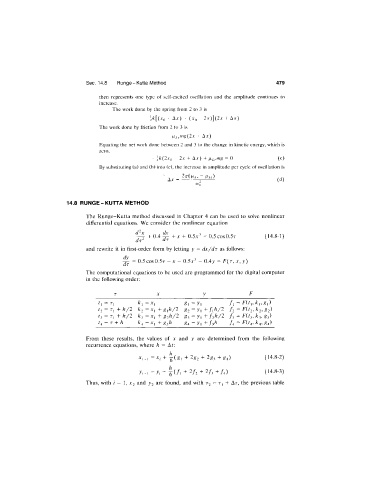Page 492 - Thomson, William Tyrrell-Theory of Vibration with Applications-Taylor _ Francis (2010)
P. 492
Sec. 14.8 Runge-Kutta Method 479
then represents one type of self-excited oscillation and the amplitude continues to
increase.
The work done by the spring from 2 to 3 is
-^/c[(jT() + Ax) -(- (X() - 2x)](2x + Ax)
The work done by friction from 2 to 3 is
/x^,mg(2x + Ax)
Equating the net work done between 2 and 3 to the change in kinetic energy, which is
-^/c(2X() - 2x Ax) + ix,^,mg = 0 (c)
By substituting (a) and (b) into (c), the increase in amplitude per cycle of oscillation is
- ^^kl)
^x = (d)
14.8 RUNGE-KUTTA METHOD
The Runge-Kutta method discussed in Chapter 4 can be used to solve nonlinear
differential equations. We consider the nonlinear equation
d'-x . . d x , . . . .
+ 0.4 -1— h X + 0.5x^ = 0.5 cos 0.5r
dr^ dr
and rewrite it in first-order form by letting y = dx/dr as follows:
^ = 0.5 cos 0.5r - x - 0.5x^ - 0.4y = E (r, x, y)
The computational equations to be used are programmed for the digital computer
in the following order:
t\=r^ gx=y\ /i = H /j,/c i, ^i)
t^ = T ^+h /2 k2=x^y-g^h/2 g2=y^-yfyh/2 f2 = F(t2,k2,g2)
^3 = T, + /t/2 k^ = Xd^ y- g 2 h / 2 g 3= y , + / 2 /z/ 2 /3 = ^ 3)
t^ = T + h / C 4 - X , + ^ 3 / 1 ^ 4 = ^ 1 + / 3^ /4 = H f 4 , /C4, g4)
From these results, the values of x and y are determined from the following
recurrence equations, where h = At:
X,+ l - + 2^2 + 2g3 + ^4) (14.8-2)
y i + \ ^ yi F -^ (/i + 2 /2 + 2 /3 + f ^ ) (14.8-3)
Thus, with / = 1, X2 and y2 are found, and with T2 = Tj + A t , the previous table

